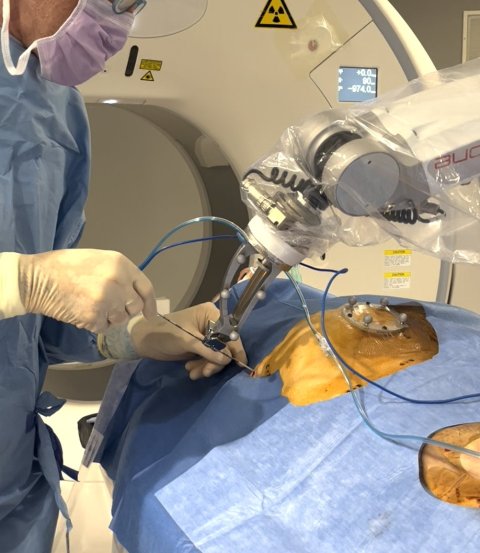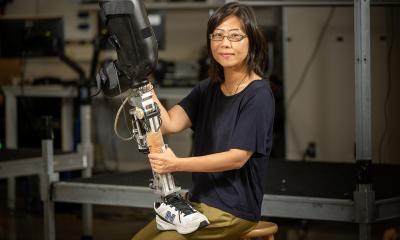Article • Improving accuracy
Robots push the boundaries of interventional radiology
Long confined to surgery, robots are making their first steps in interventional radiology. Those devices could help improve accuracy in tumour targeting during needle insertion and help less experienced radiologists perform ablations, a leading French interventional radiologist showed at the Spectrum conference in Miami.
Report: Mélisande Rouger

Robots have gone a long way ever since they were first introduced to the field of neurosurgery in 1985. Many devices are available today, and some have the potential to boost interventional procedures, according to Thierry De Baère, professor of medicine at Paris Saclay University and Head of Interventional Radiology at Gustave Roussy Cancer Centre in France.
For over a year, his team has worked with the Epione robot system from French manufacturer Quantum Surgical, which has shown promising early clinical results in more than 100 patients for ablation procedures and other needle guided procedure at Gustave Roussy. The team has used the robot for various types of procedures including cryoablation, RFA and MWA in the liver and kidney, as defined by the device’s CE mark. But the French group also used the robot off-label in bone reconstruction and lung thermal ablation. Their experience has been very positive, De Baère explained. ‘The robot is giving you the needle trajectory and placing the needle on track,’ he said. ‘The robotic system of needle insertion is safe, highly feasible and requires only a few needle adjustments. It provides efficient thermal ablation.’
Steps for robotic needle insertion include image acquisition, needle trajectory planning, robot placement, needle insertion and image verification. ‘You align the centre of the ablation to the centre of the tumour, then you’re all set and ready to send the robot,’ he said. ‘You send the arm to the location established in the treatment planning. And all you have to do is to push the needle in a single step from the skin to the target, which is something that we’re not used to.’ After the insertion, radiologists can see where the needles are and correct the position if needed.
An interesting possibility with the system is how it can expedite needle insertion in procedures where multiple needles are required, De Baère explained. ‘Tumour ablation in the kidney can be complex and time consuming if we have to stick many needles,’ he said. ‘With the robot, insertion of one additional needle was below one minute in most of our patients, and below two minutes for the rest. Once we decide our trajectory, we can go faster with the device.’
Low hanging fruits
There are several areas where the system could help advance interventional radiology, he went on. ‘The robot increases the degree of freedom for needle insertion in any plane. This could offer more stable guidance and accuracy at the time of placing the needle tip at the centre of the target,’ he said.
A second benefit concerns dose reduction. ‘As interventional radiologists we get a lot of radiation when we are working and dose matters to both patients and physicians,’ he said. ‘With a robot, it’s obvious that you can decrease radiation to physicians because they are no longer inside the room.’
One more thing De Baère hopes to achieve with the robot is more homogeneity in axial and oblique plane needle insertion. ‘In oblique plane puncture, you don’t see the whole plane during the entire needle placement,’ he said. ‘With the robot, there should be no variation, as it gives you angle free trajectory, offering a new way to approach the tumour.’
Last but not least, there is a short learning curve for the system and beginners can start working very fast with the equipment. ‘Everybody can do the same. For a beginner it’s great,’ said De Baère, who compared the performance of three experts with ten years’ experience with that of a novice without prior experience in sticking needles. ‘In just a few days, the beginner was doing as good as we have done for the past 20 years,’ he said.
Another significant benefit with the robot is its respiratory monitoring function. ‘It’s better to work under apnea, because the target is moving with the breathing, so you need to monitor that. If you cannot reproduce your breath hold, you might get the wrong target,’ he said.
Future development will need to take into account footprint, comparison of set-up time vs. manual adjustment.
Profile:
Prof. Thierry Jacques De Baère is head of the Interventional Radiology Unit at Institut Gustave Roussy Cancer Center in Villejuif, France, where he has worked since 1991. His clinical work is dedicated to minimal invasive therapy for treatment of liver, lung, and kidney tumours, including intra-arterial therapies for primary and secondary liver tumours, percutaneous ablation of liver tumours and lung tumor including radiofrequency and cryoablation. He and his team have also investigated preoperative portal vein embolization in order to hypertrophy unembolized parts of the liver, as well as SIRT.
09.01.2024











